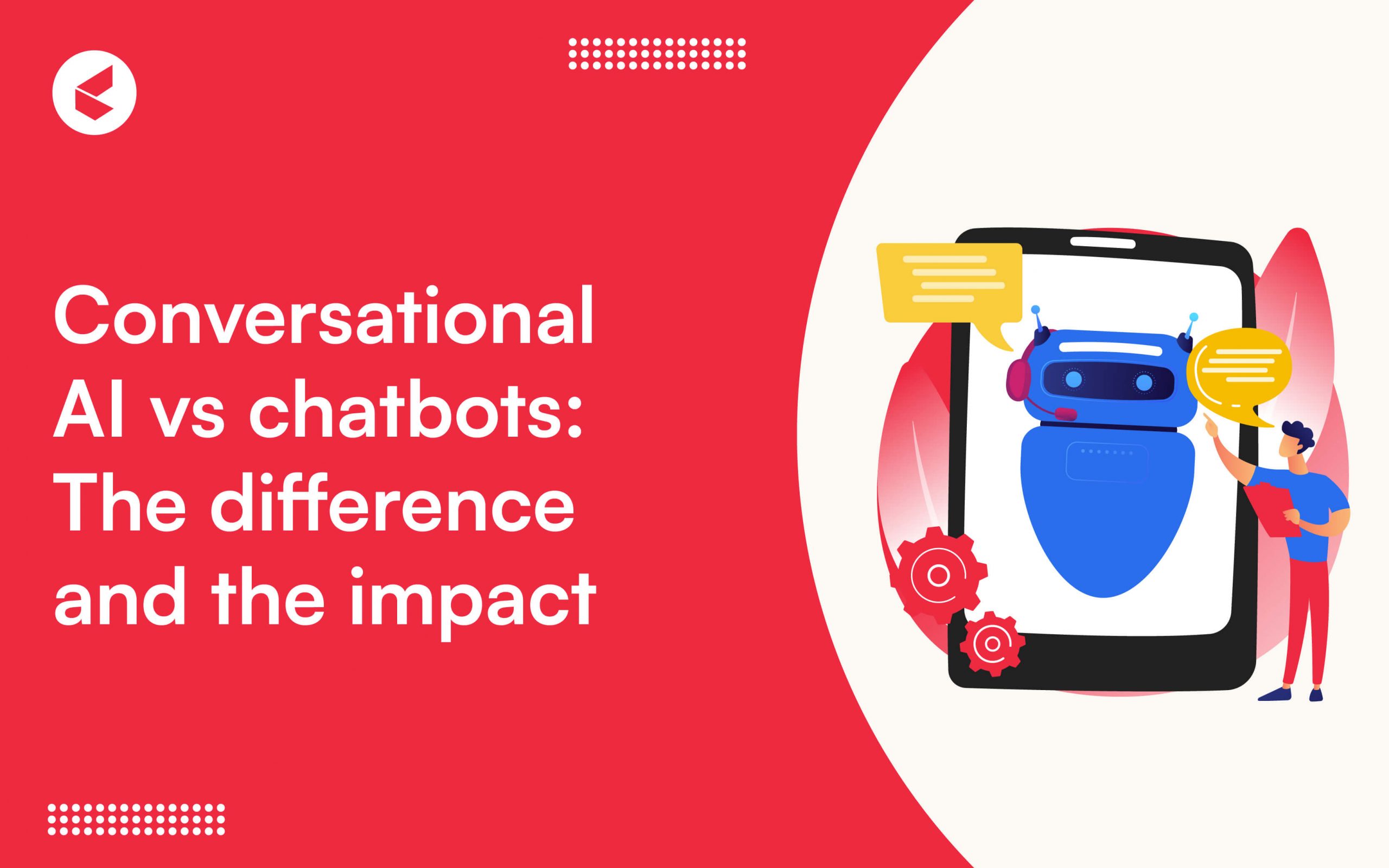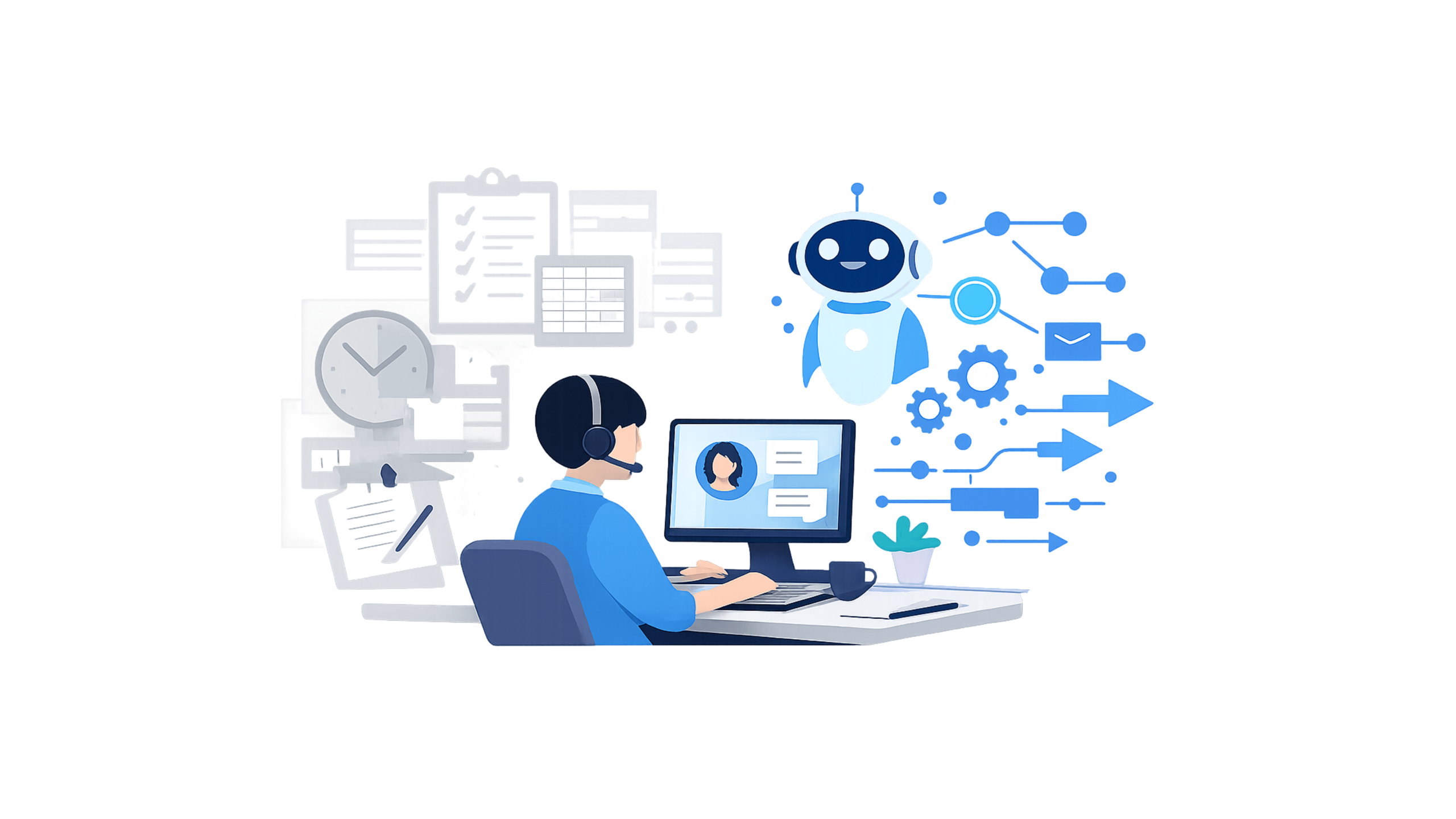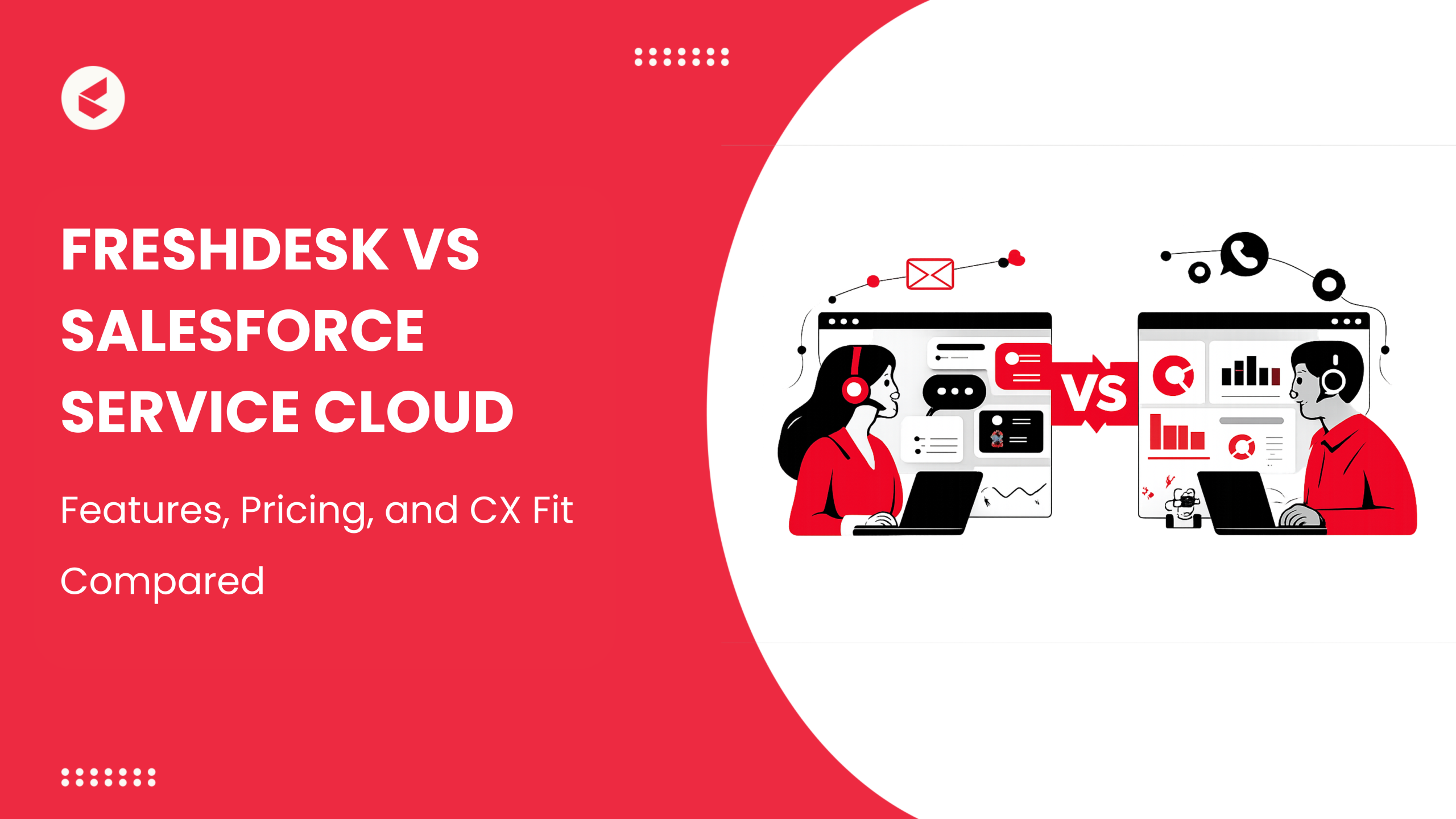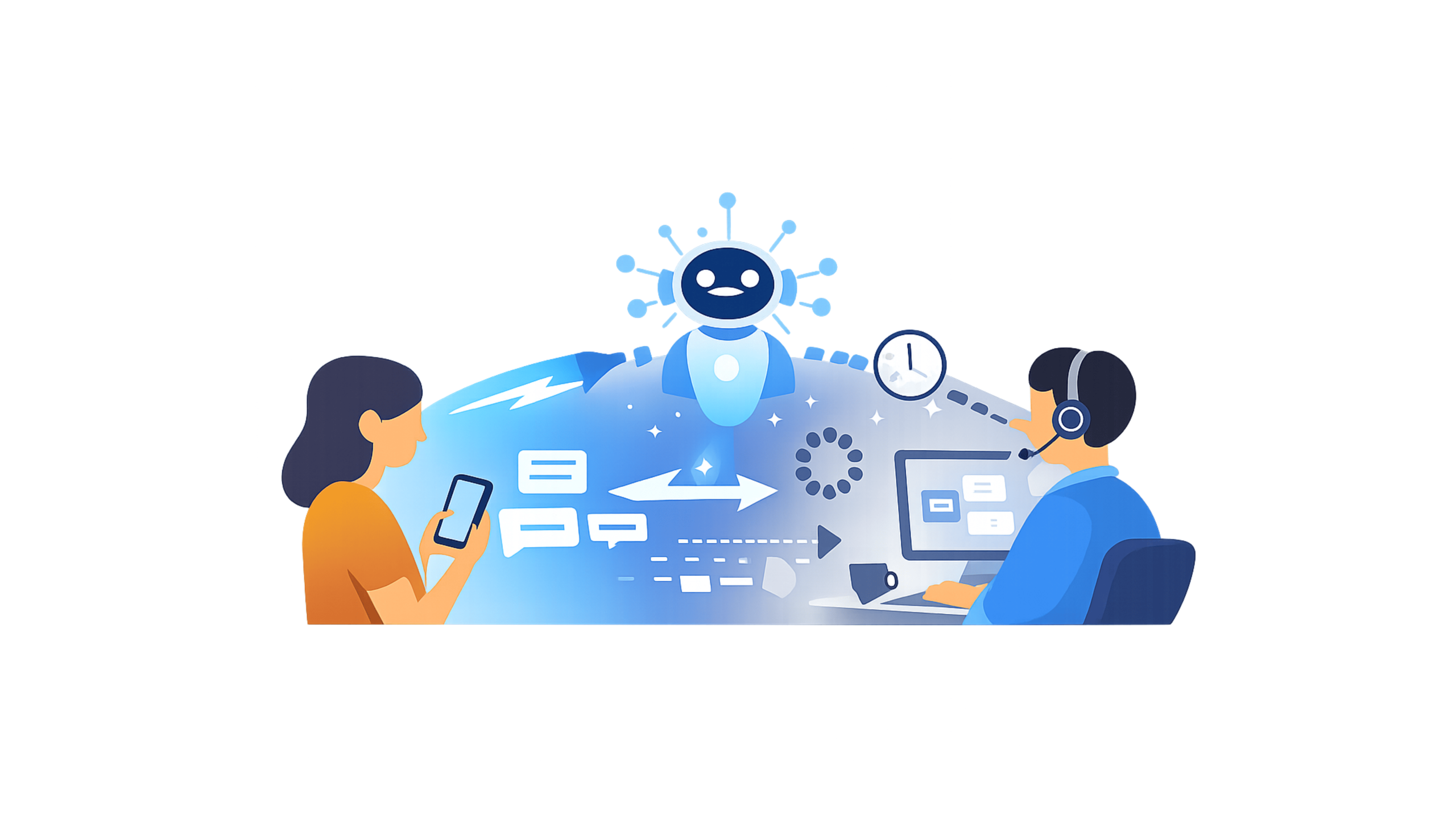Conversational artificial intelligence and chatbots are well-known technologies used in customer service. While they are often used interchangeably, they offer different approaches to customer interaction.
Chatbots deliver rule-based responses that direct consumers through pre-defined dialogues, perfect for basic questions.
On the other hand, conversational AI uses advanced knowledge and context awareness to engage customers on a personal level and handle complicated problems. In fact, Acuvate highlights that 64% of consumers agree that the technology effectively understands their emotions.
Knowing the possibilities and constraints of these technologies will help you simplify processes and improve customer service. So, let’s look at the key differences between chatbots and conversational artificial intelligence and their operations to get a clear idea of the two.
What is Conversational AI?
Conversational artificial intelligence lets machines interact with people in a human-like manner through text or speech. To achieve this, the technology relies on several advanced tools to understand and respond to human language effectively.
Let us look at some of these key tools:
1 . Natural Language Processing (NLP)
NLP lets systems evaluate and decipher human language. It performs various tasks, such as scanning through text and identifying crucial information.
2. Natural Language Understanding (NLU)
As part of NLP, NLU focuses on understanding the intent and meaning behind the user’s words, even when phrased in various ways or with slang.
3. Natural Language Generation (NLG)
NLG lets the system provide compelling, contextually relevant answers depending on its input.
4. Automatic Speech Recognition (ASR)
Voice-based interactions using ASR translate spoken words into text the AI can understand.
These technologies enable conversational artificial intelligence for smooth and accurate consumer interactions. Understanding context and human intent helps a conversational AI chatbot produce more intriguing and customized conversations.
Natural Language Processing (NLP) decodes spoken or written words; Natural Language Understanding (NLU) evaluates their meaning; and Natural Language Generation (NLG) creates relevant answers. This enables virtual assistants like Siri or Alexa to interact flexibly and seamlessly, addressing various inquiries in several environments.
With these advancements, the conversational AI platform has made remarkable strides, evolving from handling basic FAQ automation to tackling more intricate tasks. It can now manage transactional tasks like booking services, completing purchases, and even offering proactive customer support by anticipating user needs.
The ability to adapt makes conversational AI a perfect fit for businesses aiming to improve customer experiences, optimize operations, and cut costs. Gartner anticipates a 24% rise in contact center investments in 2024, primarily driven by conversational AI tools.
The surge in investment is fueled by an increasing dependence on customer-facing solutions, such as 24/7 support through AI chatbots. These innovations allow businesses to automate repetitive tasks so human agents can focus on more complex issues.
Conversational AI finds applications in healthcare, retail, finance, and even internal operations like HR support and IT troubleshooting. These technologies increasingly enhance their understanding and responsiveness, leading to more efficient and human-like interactions.
Conversational AI vs. Chatbots
Chatbots and conversational AI are tools to automate interactions between humans and machines, yet they vary in complexity and functionality.
| Feature | Traditional Chatbots | Conversational AI |
| Core Technology | Rule-based, operates on predefined scripts | AI-driven with Natural Language Processing (NLP), Machine Learning (ML), and deep learning capabilities |
| Flexibility | Rigid, struggles with unexpected or complex inquiries | Adaptive, learns from previous interactions and adjusts responses accordingly |
| Response Style | Scripted, often feels robotic and repetitive | Human-like, offers dynamic and contextually relevant responses |
| Learning Capability | Static, requires manual updates for new information | Self-learning, improves accuracy and relevance over time with ML |
| Best Use Cases | High-volume, repetitive tasks; cost-effective automation | Personalized customer support, complex inquiries, multi-channel engagement |
1. Core Differences
Traditional chatbots operate as rule-based systems, adhering to predefined scripts to engage with users. These systems are designed to react to particular keywords or commands, making them ideal for simple tasks such as answering frequently asked questions, scheduling appointments, or handling orders.
Nonetheless, they struggle with grasping context, making chatbots unhelpful or repetitive if a user’s input strays from their programmed responses. Developers confine their interactions, resulting in reactions that can feel rigid and less flexible.
Conversational AI represents a more sophisticated technology that uses AI, incorporating NLP, ML, and, occasionally, deep learning to interpret and comprehend language. This enables conversational AI systems to understand user intent, participate in ongoing dialogues, and adapt based on previous interactions.
By breaking free from rigid scripts, a conversational AI platform addresses complex customer queries, modifies responses depending on the context, and offers custom ideas. Virtual assistants like Amazon Alexa and Google Assistant are great examples of conversational AI that help people understand a range of orders and respond in a human-like way.
2. Technology and Capabilities
Technological foundation truly distinguishes these two. Traditional chatbots generally function on rule-based systems that respond to specific inputs, making them ideal for simple tasks with clear patterns.
These bots offer a budget-friendly and straightforward deployment process, yet they face challenges when managing nuanced or unexpected inquiries. Conversational AI harnesses advanced NLP and machine learning models to grasp the nuances of language, analyze data, and produce responses that are aware of the context.
These systems learn from every interaction, enhancing their capabilities over time and adjusting to new situations. This makes them perfect for businesses that need to be flexible in customer interactions.
3. Application Range and Speed
According to AI Multiple Research, 69% of customers prefer chatbots over human agents because of the speed with which they offer their services. Businesses frequently use chatbots to provide straightforward and fast customer support, guide users through menus, or enable basic transactions.
Their simple design allows them to operate effectively for businesses seeking solutions to high-volume, repetitive queries. For example, chatbots can easily manage inquiries such as “What are your store hours?” but may struggle with complicated requests.
A conversational AI chatbot knack for grasping intent and context speeds up the customer experience and opens the door to many applications.
A conversational AI chatbot achieves this by managing multi-step processes, delivering troubleshooting support, and creating personalized experiences tailored to user preferences.A
Conversational artificial intelligence provides rapid, customized support over a variety of sectors. AI-powered virtual assistants enhance user contact and satisfaction by managing appointment scheduling, responding to complex client inquiries, and providing personalized recommendations.
4. The User Experience
A key difference can be found in the user experience. Chatbots deliver quick and efficient responses for everyday tasks, yet they can seem robotic and lack flexibility when handling more complex inputs.
They use a straightforward, scripted approach, which often leads to interactions that seem rehearsed. This can create a sense of frustration when users face challenges that demand more than just basic responses.
Here, a conversational AI chatbot provides a more dynamic experience. It handles complex discussions, offers compassionate assistance, and maintains context throughout the exchange, creating the feeling of engaging with real people. This capability to tailor responses according to the user’s earlier inputs creates a more customized and enjoyable experience.
5. Choosing the Right Solution
Choosing between a traditional chatbot and a conversational AI chatbot hinges on your business’s requirements. Chatbots can be a smart and cost-effective option for operations that mainly deal with repetitive tasks like answering FAQs or giving quick updates.
Conversational AI provides flexibility and intelligence for organizations requiring deeper integrations for troubleshooting, personalized sales interactions, or handling multi-step processes.
Both technologies are essential for automating customer interactions, but their distinct capabilities, technological foundations, and application ranges define their optimal use cases.
Chatbots are great for simple tasks and saving costs, while conversational AI shines in intricate, context-rich settings. It enables businesses to enhance user experiences and optimize operations seamlessly. By grasping these distinctions, companies can adopt the most fitting technology to achieve customer service objectives.
Advantages of Using Conversational AI
Conversational AI brings various benefits that can greatly improve customer interactions and streamline business operations. Here are some key benefits:
1. Enhanced Customer Experience
According to Exploding Topics, over 52% of consumers believe that personalization enhances their satisfaction with the brand.
In this context, conversational AI systems offer a more intuitive user experience. They can grasp context, reply in a human-like way, and manage multi-turn conversations, which makes interactions feel more customized.
2. 24/7 Availability
One main advantage of conversational artificial intelligence is constant personal availability. Unlike conventional chatbots that can rely on pre-written responses, AI-driven chatbots offer dynamic, real-time interactions catered to the particular needs of every consumer.
Consumers value accurate and meaningful help any time they contact companies. In this context, conversational AI reduces wait times and ensures a consistently personalized approach.
3. Cost Efficiency
Conversational AI automates routine tasks and manages large volumes of inquiries, minimizing the necessity for extensive staffing in customer service departments. This results in substantial cost savings, allowing businesses to handle growing demands without recruiting and training extra personnel.
Additionally, research indicates that adopting AI solutions can lead to significant decreases in customer support expenses, and companies have also noted remarkable returns on their AI investments.
4. Scalability
With businesses’ growth comes an increase in customer interactions they need to manage. Conversational AI can easily adapt to meet this demand, managing multiple interactions simultaneously while maintaining high quality.
This scalability is helpful for companies experiencing seasonal peaks or fast expansion since it lets the AI automatically adjust to control higher volumes without any mistakes or delays.
5. Data-Driven Insights
Tracking and analyzing consumer interactions made possible by conversational artificial intelligence systems helps produce insightful data.
By analyzing conversational patterns, companies can learn a lot about consumer preferences, pain points, and frequently asked questions. This data can improve products, services, and consumer strategies, enabling smart decision-making and customized marketing campaigns.
6. Boosted Productivity
By letting conversational artificial intelligence oversee regular, repetitive work, human agents can free themselves to address more difficult problems requiring empathy, critical thinking, and strategic handling. This division of work increases general output and helps teams concentrate on activities that add more value to the company.
How Does a Conversational AI Platform Work?
This is how a conversational AI platform usually goes:
1. Input Processing
The interaction kicks off when a user shares input, whether it’s through text or speech. The platform utilizes Automatic Speech Recognition (ASR) to transform spoken inputs into text. This step guarantees that the system can consistently process text and voice commands.
2. Natural Language Processing (NLP)
NLP is important in grasping the user’s message. It breaks down the input into smaller elements (tokenization), identifies parts of speech, and recognizes entities such as names, dates, or products. This allows the system to grasp the context of the user’s query. NLP helps identify if a user is posing a question, making a request, or sharing a sentiment.
3. Intent Recognition and Dialogue Management
The system employs ML models to pinpoint the user’s intent (what they aim to accomplish) and gather pertinent information, including names or details associated with the query. Dialogue management guides the conversation, ensuring the AI keeps track of context and delivers clear, relevant responses. For example, when a user requests a flight change, the AI recalls the details discussed earlier and tailors its responses to fit the context.
4. Response Generation
After grasping the user intent, the platform employs Natural Language Generation (NLG) to generate a response. NLG transforms structured data into natural, readable text, allowing AI to respond in a human-like manner. This stage could include crafting a straightforward response, offering comprehensive guidance, or posing additional questions to ensure clarity.
5. Continuous Learning and Improvement
The AI gains valuable insights and evolves with every user interaction. Machine learning algorithms empower the platform to enhance understanding and improve response accuracy as time progresses. With use, conversational AI adapts to various languages and individual user preferences, enhancing its effectiveness.
6. Multi-Channel Integration
Advanced conversational AI systems are crafted to function across various channels—websites, mobile apps, social media, voice assistants, and beyond. This allows them to be adaptable for a seamless experience across multiple platforms.
The smooth blend of technologies enables conversational AI platforms to manage intricate interactions, deliver precise responses, and even mimic multi-turn dialogues, giving users a more intuitive and effective experience.
Conversational AI Use Cases
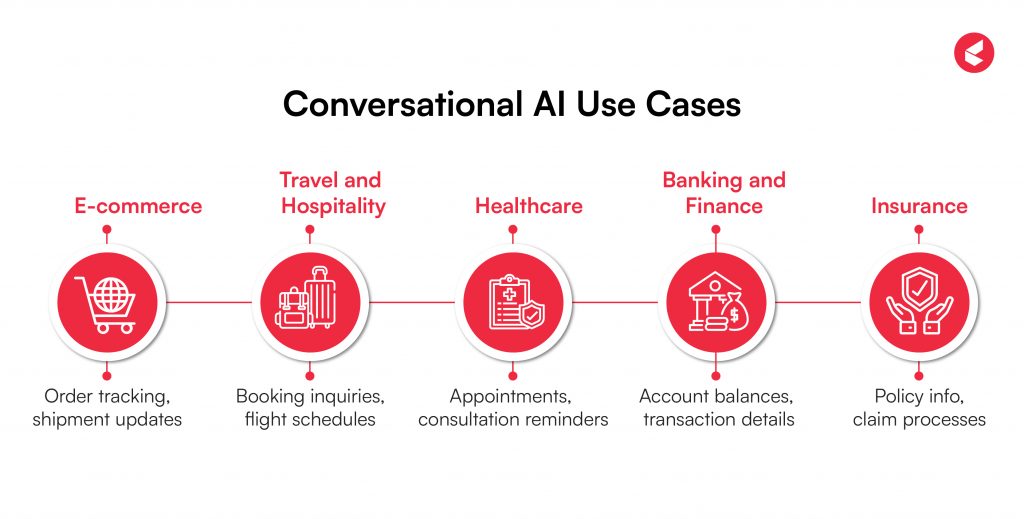
Conversational AI is now ubiquitous, transforming various industries. Explore these significant use cases of conversational AI chatbot:
1. E-commerce
In e-commerce, conversational AI enhances customer experience by streamlining order tracking and delivering real-time updates on shipment statuses.
AI-powered chatbots handle frequently asked questions regarding returns, product availability, and delivery times, enabling customers to receive prompt answers without waiting for a human agent. This enhances response times and guarantees customers feel supported during their shopping journey.
2. Travel and Hospitality
Conversational AI in the travel sector simplifies booking inquiries, manages flight schedule updates, and provides answers to questions about luggage policies.
AI assistants expertly guide users through flight changes, hotel bookings, or travel insurance details, enhancing customer interactions to be more efficient and accessible whenever needed. This proactive support alleviates travelers’ stress by offering immediate answers to urgent inquiries.
3. Healthcare
Conversational AI assistants improve customer experience in healthcare by engaging with patients to help them book appointments, remind them about upcoming consultations, and provide initial responses based on the symptoms they describe. These assistants can swiftly respond to patient inquiries regarding clinic hours, doctor availability, or pre-visit instructions.
Automating these routine tasks allows healthcare providers to concentrate on essential care services, ensuring patients receive timely assistance.
4. Banking and Finance
AI-driven chatbots in banking offer round-the-clock assistance for everyday questions such as checking account balances, viewing recent transactions, and receiving account security alerts. They assist customers with financial matters like establishing savings plans or managing expenses, improving the customer experience by providing tailored financial advice swiftly and effectively.
5. Insurance
In the insurance industry, conversational AI enhances customer service by automating updates on policy information, assisting customers in understanding their coverage, and guiding them through the claims process.
AI chatbots provide immediate responses to inquiries regarding policy renewals, premium calculations, and claims status, enhancing the customer experience and allowing human agents to focus on more intricate cases.
How to Choose the Right Conversational AI Platform for Your Business?
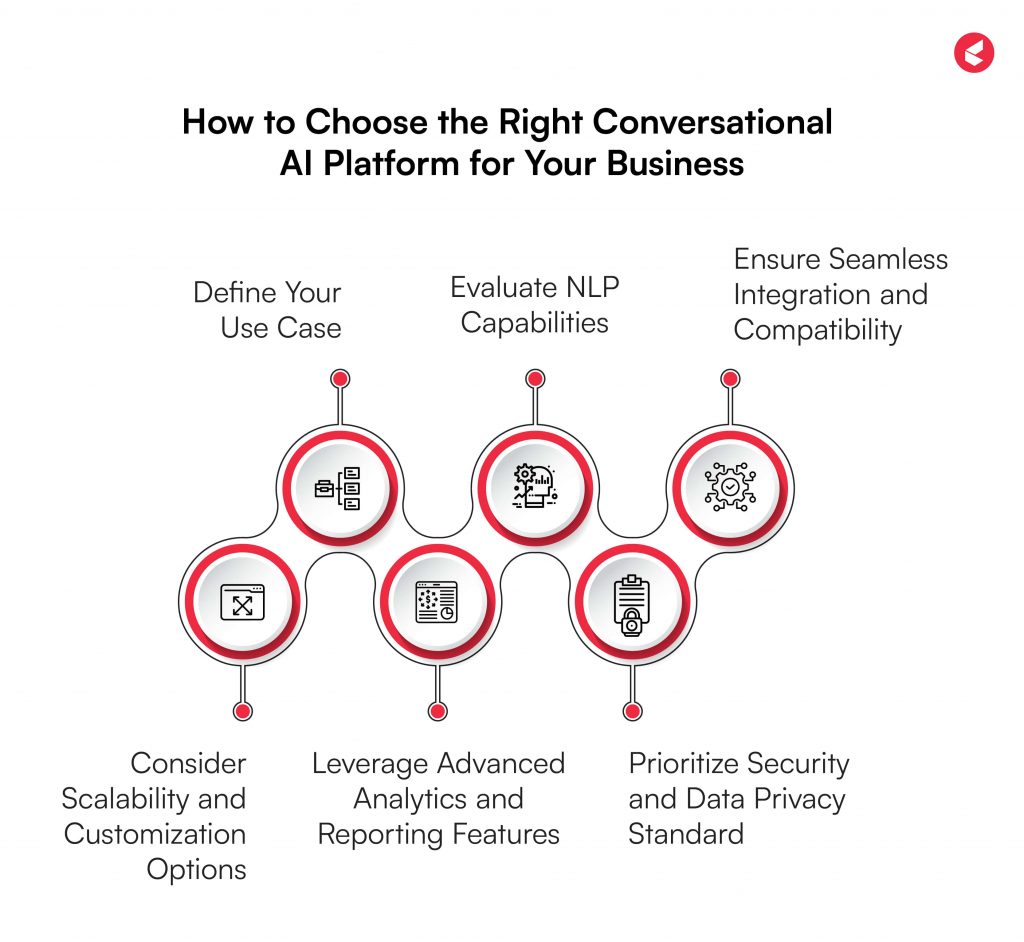
Finding the perfect conversational AI platform involves grasping your business requirements, assessing your technical abilities, and exploring the platform’s features.
Here are some important factors to keep in mind:
1 . Define Your Use Case
Begin by identifying your desired outcome. The use case definition is essential if you’re looking to enhance customer support, optimize sales, or automate HR processes. This clarity will assist you in identifying platforms specifically designed to meet your needs. To elevate customer service, seek platforms that provide adequate dialogue management and support across multiple channels.
2. NLP Capabilities
According to Statista, the NLP market is expected to be 14 times larger in 2025 compared to 2017. An effective conversational AI platform should possess strong NLP to comprehend user queries accurately. The platform’s NLP capabilities guarantee accurate, human-like responses, making them crucial for delivering a seamless user experience.
3. Integration and Compatibility
The platform must seamlessly connect with your current systems, including CRMs, databases, and other software. The smooth integration process enhances implementation and guarantees that the AI can tap into relevant data to provide tailored responses. Platforms that offer open APIs tend to facilitate smoother integration with various tools.
4. Scalability and Customization
Choose a solution that evolves alongside your business. Look for customization options that enable you to shape the AI’s responses, persona, and functionality to match your brand identity perfectly.
5. Analytics and Reporting
Explore platforms that provide comprehensive reporting features, including customer interaction logs, response accuracy, and resolution times. This information allows you to enhance the AI’s replies and boost customer interaction over time.
6. Security and Privacy
According to Cloud Security Alliance, around 63% of experts believe AI can enhance security measures. Make sure you make the most of it by ensuring the platform complies with security standards, particularly when handling sensitive information. Essential features such as data encryption, user authentication, and adherence to regulations like GDPR are crucial in safeguarding customer data
The Best AI Chatbots of 2025
The following are some of the best AI chatbots to consider in 2025:
1. ChatGPT (OpenAI): Renowned for its conversational fluency, ChatGPT stands out as one of the most advanced AI chatbots on the market. It tackles various queries, participates in natural conversations, and provides contextually relevant responses. Businesses leverage ChatGPT for a wide range of applications, from enhancing customer support to generating engaging content, all due to its remarkable adaptability and integration capabilities.
2. IBM Watson Assistant: Watson is a dependable option for businesses seeking a powerful AI solution. It truly shines in grasping context, delivering tailored responses, and seamlessly connecting with various business systems. It also boasts powerful analytics, allowing companies to enhance customer interactions continuously.
3. Google Dialogflow: Google Dialogflow is a well-known platform for creating engaging voice—and text-based conversational applications. It offers support for various languages and seamlessly integrates with Google’s suite of products, making it a fantastic choice for businesses seeking scalable and multi-channel solutions. Its machine-learning capabilities enable it to learn from interactions and enhance itself over time.
4. Rasa: Rasa is an open-source platform that empowers businesses to create tailored conversational AI solutions without vendor lock-in constraints. It provides many tools for designing, launching, and overseeing conversational agents. Rasa’s flexibility and modularity empower companies to craft customized solutions that perfectly align with their unique requirements.
Conclusion
Traditional chatbots work on a rule-based system to efficiently manage simple, repetitive tasks such as responding to FAQs or delivering basic information. Yet, they struggle with more intricate or tailored interactions.
Conversational AI, on the other hand, surpasses basic automation. It provides tailored responses and participates in fluid, human-like dialogues by grasping context and intent. This is perfect for enhancing customer satisfaction with responsive and dynamic services.
Businesses must consider their needs when choosing between these technologies. Chatbots excel at providing cost-effective and straightforward automation, whereas conversational AI brings the flexibility needed for deeper customer interaction and handling complex inquiries.
Looking to streamline your customer interactions and enhance service efficiency? Kapture CX’s intelligent platform offers the best AI chatbot solutions for managing customer support across various channels.
Contact the team today for a hyper-personalized customer experience that drives satisfaction.
